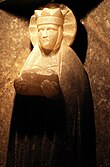Wieliczka Salt Mine
From Wikipedia, the free encyclopedia
| Wieliczka Salt Mine* | |
|---|---|
| UNESCO World Heritage Site | |
 |
|
| State Party | |
| Type | Cultural |
| Criteria | iv |
| Reference | 32 |
| Region** | Europe and North America |
| Inscription history | |
| Inscription | 1978 (2nd Session) |
| Endangered | 1989-1998 |
| * Name as inscribed on World Heritage List. ** Region as classified by UNESCO. |
|
The Wieliczka Salt Mine, located in the town of Wieliczka, is within Poland's Kraków metropolitan area. It had been until 2007 in continuous operation, producing table salt, since the 13th century. It was one of the world's oldest operating salt mines (the oldest being in Bochnia, Poland, some 20 kilometers distant from Wieliczka).
[edit] Touring
Active mining was discontinued in 1996 due to low salt prices and mine flooding. The mine remains a major tourist attraction.
|
The mine reaches a depth of 327 meters, and is over 300 km long.
The Wieliczka salt mine features a 3.5-km. tour for visitors (less than 1% of the length of the mine's passages) that includes statues of historic and mythic figures. The older works were sculpted by miners out of rock salt; more recent figures have been fashioned by contemporary artists. Even the crystals of the chandeliers are made from rock salt that has been dissolved and reconstituted to achieve a clear, glass-like appearance. The rock salt is naturally grey, in various shades like granite, so that the carvings resemble carved unpolished granite rather than having the white or crystalline appearance that many visitors expect. (The carvings appear white in the photos below; the actual carved figures are not white.)
Also featured is a large chamber with walls carved to resemble wooden chapels built by miners in earlier centuries; an underground lake; and exhibits on the history of salt mining. The mine is often referred to as "the Underground Salt Cathedral of Poland."
About 1.2 million people visit the mine each year.
Over the centuries, visitors to this site have included Nicolaus Copernicus, Johann Wolfgang von Goethe, Alexander von Humboldt, Dmitri Mendeleyev, Bolesław Prus, Ignacy Paderewski, Robert Baden-Powell, Jacob Bronowski (who filmed segments of The Ascent of Man in the mine), Karol Wojtyła (who later became Pope John Paul II), former U.S. President Bill Clinton, and many others.
During World War II, the salt mine was used by the occupying Germans as facilities for war-related production plants.
To get down to the 150-meter level of the mine, visitors must walk down a wooden stairway of some 400 steps. After the 3 kilometer tour of the mine's corridors, its chapels, statues and lake, visitors take an elevator back up to the surface. The elevator holds 36 people (9 per car) and takes roughly 30 seconds to reach the surface.
The salt mine helped inspire the Labyrinth scenes in Bolesław Prus' 1895 historical novel, Pharaoh.[1]
In 1978 the Wieliczka salt mine was placed on the original UNESCO roster of World Heritage Sites.
[edit] Photos
| Wieliczka salt mine | |||
 headframe |
 carved in rock salt |
 carved in a wall of rock salt |
 |
 of Pope John Paul II |
 in the museum |
 St Kunegunda's Shaft |
 at St Kinga's Chapel |
[edit] See also
- Pharaoh — historical novel by Bolesław Prus
- Bochnia
- Chełm Chalk Tunnels
- Salt Cathedral of Zipaquirá, in Zipaquirá, Cundinamarca, Colombia
[edit] Notes
- ^ Christopher Kasparek, "Prus' Pharaoh and the Wieliczka Salt Mine," The Polish Review, 1997, no. 3, pp. 349–55.
[edit] References
- Jerzy Grzesiowski, Wieliczka: kopalnia, muzeum, zamek (Wieliczka: the Mine, the Museum, the Castle), 2nd ed., updated and augmented, Warsaw, Sport i Turystyka, 1987, ISBN 83-217-2637-2.
- Christopher Kasparek, "Prus' Pharaoh and the Wieliczka Salt Mine," The Polish Review, 1997, no. 3, pp. 349-55.
[edit] External links
| Wikimedia Commons has media related to: Wieliczka |
- Official website
- Wieliczka Salt Mine - UNESCO World Heritage Centre
- Wieliczka salt mine
- Video tour of mine
- Ancient salt-works
- Cracow Salt-Works Museum in Wieliczka (plan of mine)
- Wieliczka Salt Mine near Krakow in Poland
- Air Pollution Intrusion into the Wieliczka Salt Mine
- "A Piece of Salt that Weighs 200 Tons" fallen from Wieliczka chamber roof in 1916; Popular Science monthly, Feb 1916, page 179. Scanned by Google Books.
|
|||||||

